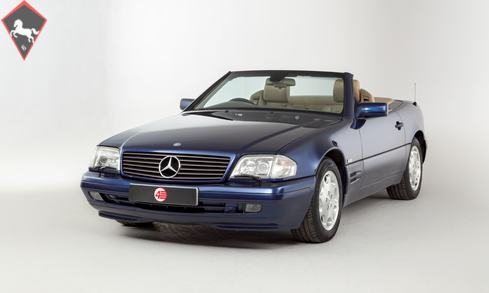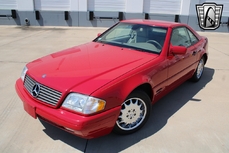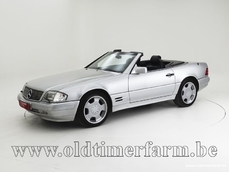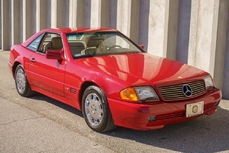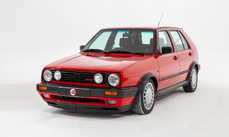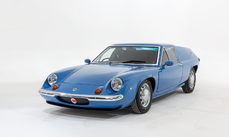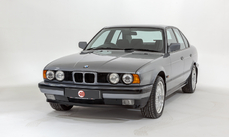Mercedes-Benz 500SL r129 SL500 1996
General description :
Model History
Designed and built as a grand tourer the SL was first introduced in 1954. The designation SL derives from the German "Sport Lightweight" and was first applied to the 300SL Gullwing. The SL model range is still in production today and has spanned five generations of models from 1954 to the present day.
The R129, as featured here, is the fourth generation of SL and was built from 1989-2002. Featuring a shorter wheelbase and updated rear suspension over its predecessor, the R107, the R129 was quick to introduce model updates and featured a large amount of styling, mechanical, and technological updates over its 12 year life span.
The R129 shot to the public's attention in 1991 when Diana, Princess of Wales sold her Jaguar to purchase a 500SL. This sparked a media storm as this was the first time a member of the royal family had chosen a foreign car. The media questioned whether British royalty should be driving foreign cars and eventually due to pressure she was forced to return the car to Mercedes-Benz in 1992. The car now features in the Mercedes-Benz Museum.
Equipment
Azurite Blue Metallic paintwork, Beige leather upholstery, Panoramic removable hardtop, Rear seats, Soft-top in black, Heated and electrically adjustable front seats with multi-contour adjustment, Xenon headlamps with wash/wipe, Heated driver’s door mirror, Leather steering wheel with wood trim, Leather gear selector, Mercedes first aid kid, Mercedes tool roll, Remote central locking, Alarm, Immobiliser, Mercedes overmats.
Exterior
This V8 SL is well presented in timeless Azurite Blue Metallic with contrasting beige leather upholstery, a striking combination perfectly offset by the freshly diamond-cut alloy wheels. The glossy paintwork shows relatively few signs of age with a deep shine to the upper panels and only discreet marking to the satin lower sections. There are no car park dings to be found either side, and the Xenon headlamps are still nice and clear.
This two-owner example was specified from new with the desirable panoramic glass hardtop option. With that removed, the electric folding soft-top operates smoothly at the touch of a button; the fabric is remarkably unworn and there’s no unsightly damage to the rear windows.
Additional photos, videos, and inspection report provided on request. FREE DELIVERY available within 150 miles - please call us for a discounted rate if you live further away.
Interior
The airy cabin boasts a glossy walnut finish to the centre console, door panels, and steering wheel rim. Looking across the desirable multi-contour front seats the upholstery appears in wonderful condition with only minimal wear to the bolsters; the sought-after rear seats are trimmed in the same supple leather and are free from any marking. The centre console presents in excellent condition showing no scratches or wear to the trim. At the rear of the car the boot area is still perfectly tidy, neatly housing the Mercedes first aid kit and removable wind defector with cover.
ENGINE & TRANSMISSION
The 5-litre V8 is a perfect complement to the R129. With effortless power delivery and a smooth five-speed ‘box this example feels extremely capable and is an absolute joy to drive. Lifting the bonnet you’ll find the engine bay still looking fresh and with the sound-deadening material still pleasingly intact. The SL has covered only 64k miles from new and is accompanied by an excellent maintenance record, with the last eight services having all been done at Mercedes-Benz in the correct A/B order.
WHEELS, TYRES & BRAKES
The classic eight-hole alloys suit the R129 well and fill the arches nicely. Having just been fully refurbished to the highest standards by Lepsons all the wheels are in pristine condition and boast the correct polished finish. They are wrapped in a matching set of Michelin tyres that were fitted at 58k miles in 2017.
History File
The SL was first registered in Hong Kong in 1996 and has seen just two owners from new. The current owner purchased the car way back in 2001 and has cherished it ever since. It has been extremely well maintained under his care and is accompanied by a comprehensive and primarly main dealer service record. The most recent service was carried out at Mercedes-Benz of Guildford in August 2019 at the current mileage of 64k. The MOT is valid until August 2020.
http://www.4starclassics.com/for-sale/mercedes-r129-sl500-for-sale-3/
1996 Mercedes-Benz 500SL r129 SL500 is listed sold on ClassicDigest in Kingsley by 4 Star Classics for £12495.
Car Facts
Car type : Car Make : Mercedes-Benz Model : 500SL r129 Model Version : SL500 Engine size : 5.0 Model Year : 1996 Sub type : Pick up Location : Hampshire
Sold
Seller Information
Sold
People who viewed this Mercedes-Benz 500SL r129 also viewed similar Mercedes-Benz listed at ClassicDigest
Other cars listed for sale by this dealer
About Mercedes-Benz
In the annals of automotive history, the journey of Mercedes-Benz is a tale that unfolds with the ingenuity of its founding pioneers. In the year 1886, Karl Benz crafted the Benz Patent Motorwagen, a creation that would go down in history as the world's inaugural automobile. Unbeknownst to him, this moment marked the genesis of what would evolve into the most illustrious premium car manufacturer globally. The financial underpinning of this pioneering venture, interestingly, was provided by Karl Benz's wife, Bertha Benz, demonstrating a remarkable partnership that would set the tone for Mercedes-Benz's legacy.A parallel narrative emerged not far away, as Daimler-Motoren-Gesellschaft, founded by Gottlieb Daimler and Wilhelm Maybach, entered the scene. In 1901, they unveiled their automobile under the now-famous moniker "Mercedes," meaning "godsend" in Spanish. This name was bestowed upon the car at the behest of Emil Jellinek's daughter, the distributor for Daimler-Motoren-Gesellschaft. The wheels of innovation were set in motion.
Fast forward to 1926, a pivotal year that witnessed the merger of Daimler with Benz & Cie., culminating in the birth of Daimler-Benz. The amalgamation saw the adoption of "Mercedes-Benz" as the distinguished trademark for their automobiles, fusing the legacies of two visionary entities into one.
Contrary to perceptions of conservatism, the trajectory of Daimler-Benz unfolds as a chronicle of industry firsts. From the introduction of the honeycomb radiator to the float carburetor, and the pioneering implementation of four-wheel brakes in 1924, Daimler-Benz consistently pushed the boundaries of automotive innovation. The diesel-powered Mercedes-Benz 260 D in 1936 marked the inception of diesel engines in passenger cars. The iconic Mercedes-Benz 300SL Gullwing made history as the first car with direct fuel injection, albeit the Gutbrod's tiny 2-stroke engine can claim precedence.
Safety innovations became a hallmark, with Béla Barényi's patented safety cell design in the "Ponton"-models in 1951, featuring front and rear crumple zones. The W116 450SEL 6.9 saw the introduction of the Anti-Lock Brake system (ABS), another pioneering safety feature. From the first production airbags and beyond, the legacy of "firsts" continued to be etched into the fabric of Daimler-Benz.
Over its centennial journey, Mercedes-Benz has not merely produced cars but has sculpted automotive icons. The SSKL, 710 SSK Trossi Roadster, 770K Grosser, 540K Spezial Roadster, 300SL Gullwing, w100 600 Pullman, w111 280SE 3.5 Flachkühler, w113 230SL Pagoda, w109 300 SEL 6.3, and w201 2.3-16 Cosworth stand testament to the brand's commitment to engineering excellence.
The roaring Silver Arrows, or "Silberpfeile," including the W 25, W 125, W154, W165, and W196, created a legacy of dominance on the racetrack. These machines were not merely cars; they were expressions of precision, speed, and an indomitable spirit that left their competitors in the dust.
As Mercedes-Benz marches into the future, it does so not just as an automaker but as a custodian of a legacy, a torchbearer of innovation, and a beacon of automotive excellence. The road ahead is sure to witness the continued fusion of cutting-edge technology, timeless design, and an unwavering commitment to setting new standards in the world of automobiles.
One luminary figure who left an indelible mark was Béla Barényi, often heralded as the "father of passive safety" for his pioneering work in safety engineering. His patented safety cell design, featuring front and rear crumple zones, became a hallmark of Mercedes-Benz's commitment to occupant safety, setting new standards that reverberated throughout the automotive world.
Moving through the chronicles, the collaborative genius of Wilhelm Maybach, alongside Gottlieb Daimler, laid the foundation for Daimler-Motoren-Gesellschaft. Their innovations not only birthed the first Mercedes but established a culture of relentless pursuit of technological excellence that remains integral to Mercedes-Benz's DNA.
In the post-merger era of 1926, Ferdinand Porsche emerged as a prominent figure within Mercedes-Benz. His work on the Mercedes-Benz S-Type, a supercharged race car, garnered acclaim and set the stage for a legacy that extended far beyond the marque. Porsche's impact would later extend to his eponymous company, but his influence at Mercedes-Benz during those formative years was pivotal.
As the 20th century progressed, the legendary Rudolf Uhlenhaut emerged as a key figure. Uhlenhaut, an accomplished engineer and the driving force behind the iconic Silver Arrows, played a crucial role in Mercedes-Benz's dominance in motorsports. His engineering prowess and attention to detail were instrumental in creating some of the most formidable racing cars of the era.
In the latter half of the century, figures like Bruno Sacco, the head of design at Mercedes-Benz from 1975 to 1999, left an indelible imprint on the brand's aesthetic identity. Sacco's design philosophy, characterized by clean lines and timeless elegance, shaped iconic models like the W126 S-Class and the W201 190E, solidifying Mercedes-Benz's reputation for luxury and sophistication.
The narrative would be incomplete without acknowledging the contributions of engineers like Hans Scherenberg, whose leadership in the 1970s ushered in a new era of technological innovation at Mercedes-Benz. Scherenberg's tenure saw the development of groundbreaking technologies, including the Anti-Lock Brake system (ABS) and the introduction of airbags in production cars.
